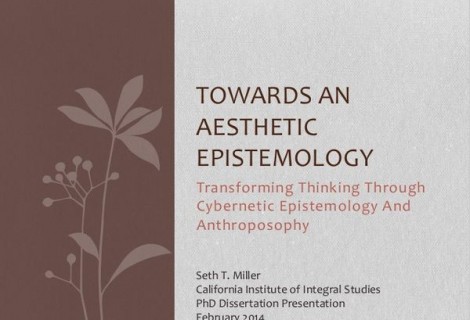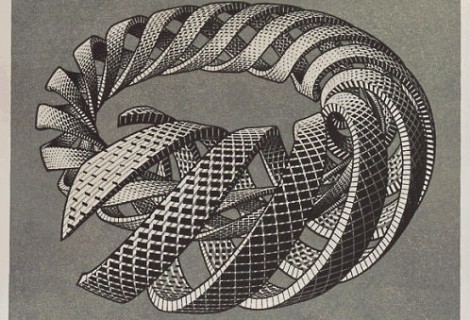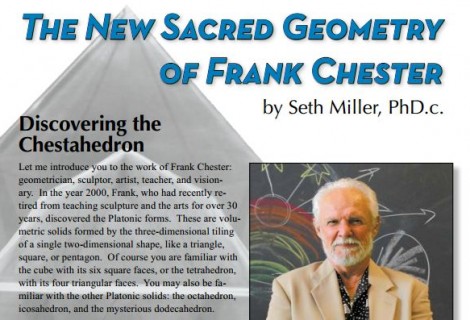An Esoteric Guide to Spencer Brown’s Laws of Form #5
« Previous Page | 1 2 3 4 5 | View All | Next Page »
(New readers will want to start with the first installment.)
We ended the last installment with a recognition that the Laws of Form naturally led GSB to an understanding of both the necessity and importance of the realm of imaginary numbers. We will continue this elaboration.
You are likely familiar with the paradoxical sentence: “This sentence is false.” Is it false or true? The answer is yes, and it depends on when you ask me. It was this kind of paradox that drove Russell and Whitehead into creating their Theory of Logical Types, which was designed specifically to prevent this kind of thing from simply ever coming up in the first place. GSB is not so limited, and understands the importance of formally including paradox in his calculus. So how does he deal with this?
He points out that we are driven to a higher order of logic, one that includes re-entry. In the first Esalen lecture, GSB states that
- “This has been totally overlooked in mathematics, that i is in an oscillatory state. Because in order to get over this paradox of x-squared equals minus one, we see that we can’t use any ordinary form of unity so we invent in mathematics another form of unity and we-call it i, which is the root that satisfies that equation.”
Let me continue quoting him at length, because his own dialogical presentation is quite apt:
- It is really an oscillation defining time; but it is the first time, and, therefore, being the first time, the oscillations are without duration, so the wave has no shape at all. Just as the space of the first distinction has no size, no shape, no quality other than being states. This is one of the things that tend to upset people. It is part of the mathematical discipline that what is not allowed is forbidden. That is to say, what you don’t introduce, you can’t use. And until you have introduced shape, size, duration, whatever, distance, you can’t use it.
- In the beginning of Laws of Form, we defined states without any concept of distance, size, shape–only of difference. Therefore the states in Laws of Form have no size, shape, anything else. They are neither close together nor far apart, like the heavenly states. There is just no quality of that kind that has been introduced. It’s not needed.
- The same with the first time. The first time is measured by an oscillation between states. The first state, or space, is measured by a distinction between states. There is no state for a distinction to be made in. If a distinction could be made, then it would create a space. That is why it appears in a distinct world that there is space.
- Space is only an appearance. It is what would be if there could be a distinction.
- Similarly, when we get eventually to the creation of time, time is what there would be if there could be an oscillation between states. Even in the latest physics, a thing is no more than its measure. A space is how it is measured; similarly, time is how it is measured. The measure of time is change. The only change we can produce–when we have only two states–the only change we can produce is the crossing from one to another. If we produce an expression, like the ordinary expressions in the algebra, we have to make the crossing. We have to do something about it. We have to operate from the outside. If we produce that cross that feeds into itself, now we don’t have to do any thing. It is a clock, just as an ordinary distinction is a rule. A rule makes or defines space, and a clock defines time. In making our first distinction all that we have done is introduce the idea of distinction. We have introduced nothing else. No idea of size, shape, distance, and so on. They do not exist, not here. They can be constructed, and they will be, but not yet. They are what happens when you feed the concept back into itself enough times.
- Again, when you first construct time, all that you are defining is a state that, if it is one state, it is another. Just like a clock, if it is tick, therefore it is tock. But this time is the most primitive of all times, because the intervals are neither short nor long; they have no duration, Just as these states have no size.
All we need to add is that when he says “In making our first distinction all that we have done is introduce the idea of distinction. We have introduced nothing else.” we can recognize something of the complexity of what this idea of distinction is, and how it acts.
I’m going to let GSB’s own remarks on space and time stand without further exploration, although I don’t imagine it needs to be pointed out how central the concept of vibration (and rhythm) is to esoteric work. Rather, I’m going to get back to LoF and continue with commentaries on chapter 12, where he summarizes the whole work.
LoF p. 69
- The conception of the form lies in th e desire to distinguish.
Esoterically, all knowing, all epistemology, always includes the WILL; i.e. activity; it is never passive.
LoF p. 69
- Granted this desire, we cannot escape the form, although we can see it any way we please.
The form can be anything in terms of its manifestation, but to get from the second order level to the first REQUIRES that a form be chosen. In other words, the first distinction is always dual: it is both the distinction of a particular FORM of distinction (from all the other possible forms of distinction), and it is also the distinction of distinction itself. This is to say, the first distinction is recursive, having both a first and second-order nature. The recursion is particular: it is between the first and second orders of the distinction. This means that the process of making the first distinction is the content of the first distinction. In other words, the first distinction is simultaneously ontological and epistemological: what is distinguished IS (ontologically) DISTINGUISHED (epistemologically). The form is recursive: what is distinguished is distinguished by what is distinguished by what is … and so on. This should all make sense now.
LoF p. 69
- The calculus of indications is a way of regarding the form.
But there are many/infinite ways of regarding the form. This is a necessary correlate to the 1st/2nd order recursion of the first distinction. That is to say, freedom is both an epistemological and ontological reality: the content of the form and the coming into being of the form are not arbitrarily bound, except to that very fact (their recursion with each other as we have already seen).
LoF p. 69
- We may also note that the sides of each distinction experimentally drawn have two kinds of reference.
- The first, or explicit, reference is to t he value of a side, according to how it is marked.
- The second, or implicit, reference is to an outside observer. That is to say, the outside is the side from which a distinction is supposed to be seen.
In other words, every distinction implies more than the distinction, but also that which distinguishes. Alternately, we can say that behind every distinguished space lies another space, as yet undistinguised, but potentially distinguishable. Esoterically, this is recognition of a hierarchy of epistemological and ontological levels. Included is the implication that to distinguish the space from which a distinction is made requires a transformation, whereby the new distinction occurs from outside the original space. I.e. the distinction must come from further “outside” the space. In esoteric traditions this can be expressed in different ways, but the most directly cognate is Sri Ramana Maharshi’s question: “Who is asking the question?”. The recognition here is that one can directly address (and thus work on, train, implement) the potential to distinguish a higher space from which a distinction is made, and so on.
LoF p. 76
- In this conception a distinction drawn in any space is a mark distinguishing the space. Equally and conversely, any mark in a space draws a distinction.
Esoterically, one cannot not act. In other words the fact that “one” is “one” implies already the distinction of “one”. It is not possible to remove “one” from “one cannot not act”; conversely, all action thus implies “one”, i.e. the actor, which is exactly why GSB says immediately following this that:
LoF p. 76
- We see now that the first distinction, the mark, and the observer are not only interchangeable, but, in the form, identical.
This should be quite clear now, and is one of the keys to the esoteric meaning of LoF. GSB essentially shows us, in his own way, that at their roots, epistemology and ontology form a unity. The operation of the mark is simultaneously the mark of the observer and is the observer. The mark as an epistemological act is also the bringing forth of an ontology. Conversely, and following form the last remark, there is no observer that does not make a mark, a mark which is coincident with — nay, even, as GSB indicates, identical with — the ontology of the observer.
Said more plainly:
–What you distinguish constitutes what you know.
–What you distinguish constitutes what you are.
Or, more cryptically poetic:
–You are what you know when you know what you are.
This has profound consequences. Because ontology and epistemology are recursively linked at their very base, it means that knowing is always linked to being, and that we can know being, because we are being knowing.
This relation, which is esoteric at heart, banishes the specter of Kant’s noumenal world: there is no being, no ontology, which is without its epistemology. This is to say that there is no “thing in itself” (every mark has a definite value for its space, which is always beyond the mark, and implicated by it, i.e. the fact of the mark implies the fact of the unmarked mark), and likewise there is no “think in itself” (every mark is a mark in a space that is marked, i.e. the content of the mark is what is marked).
Here ends the formal chapters of LoF, but GSB continues for almost another 60 pages with notes designed to help lead the reader through the main text, or to elaborate on what is found there. It contains some fascinating esoteric nuggets. To wit:
LoF p. 77
- It may be helpful at this stage to realize that the primary form of mathematical communication is not description, but injunction. In this respect it is comparable with practical art forms like cookery, in which the taste of a cake, although literally indescribable, can be conveyed to a reader in the form of a set of injunctions called a recipe. Music is a similar art form, the composer does not even attempt to describe the set of sounds he has in mind, much less the set of feelings occasioned through them, but writes down a set of commands which, if they are obeyed by the reader, can result in a reproduction, to the reader, of the composer’s original experience.
This exactly describes the nature of esoteric communication; its data cannot be conveyed directly, but the process leading to the data can be, which means that the data proper to esoteric communication is that of the process which leads to its data. Indeed the whole of LoF can be taken this way, and is meant to be, as made implicit by GSB in the above quote. Continuing in this vein:
LoF p. 78
- In his introduction to the Tractatus, Russell expresses what thus seems to be a justifiable doubt in respect of the rightness of Wittgenstein’s last proposition when he says [p 22]
- “what causes hesitation is t he fact that, after all, Mr. Wittgenstein manages to say a good deal about what cannot be said, thus suggesting to the sceptical reader that possibly there may be some loophole through a hierarchy of languages or by some other exit.”
- The exit, as we have seen it here, is evident in the injunctive faculty of language.
That is, to indicate that which cannot be indicated, one can indicate a process which, when followed, generates the indication. This is simply to indicate the esoteric process, i.e. transformation, the building of capacity. It is necessarily recursive; following the procedure generates itself (and more). Now:
LoF p. 78
- But in each case the description is dependent upon, and secondary to, the set of injunctions having been obeyed first.
This is the KEY insight into understanding esoteric communication. Process BEFORE product. It can thus be indicated that the key to esoteric work is the activity of the WILL, primarily in ATTENTION. By changing how we direct our attention, we can progress esoterically.
LoF p. 80
- Naming may thus be considered to be without direction, or, alternatively, pan-directional. By contrast, instruction is directional, in that it demands a crossing from a state or condition, with its own name, to a different state or condition, with another name, such that the name of the former may not be called as a name of the latter.
This procedure of naming, because of its pan-directional nature, can be seen to have resonances with the importance of naming esoterically, i.e. naming is evocation, a literal calling forth, the bringing forth of a reality through the making of a distinction in the calling of a name. Even more, a name is, esoterically, indicative of the coming-into-being of the named; the name names the process-level of the being, not the first-order level of the being-as-already-become.
The second piece here is indicative of the context for naming, i.e. the importance of following a PARTICULAR sequence in order to arrive at a particular name. Esoterically, this is the integration of timing into injunctions, which has its outermost expression in the sense of ritual. In other words, esoteric ritual, such as meditative practice, prescribes a definite sequence which yields TRANSFORMATION, i.e. the generation of a capacity to name (distinguish) new states.
Immediately following the last quote:
LoF p. 80
- The more important structures of command are sometimes called canons. They are the ways in which the guiding injunctions appear to group themselves in constellations, and are thus by no means independent of each other. A canon bears the distinction of being outside (i.e. describing) the system under construction, but a command to construct (e.g. ‘draw a distinction’), even though it may be of central importance, is not a canon. A canon is an order, or set of orders, to permit or allow, but not to construct or create.
In this strange passage is indicated, from an esoteric standpoint, that in esoteric development, the path can only be indicated, not forced. In other words, FREEDOM is an essential component of the path of spiritual development, in the sense that esoteric injunctions (and their groupings into various ‘systems’ or ‘rituals’, i.e. the ‘canon’) take the form: “if you do X, then Y is a consequence”, NOT the more aggressive “DO X …”.
Again, immediately following the previous quote:
LoF p. 80
- The instructions which are to take effect, within the creation and its permission, must be distinguished as those in the actual text of calculation, designated by the constants or operators of the calculus, and those in the context, which may themselves be instructions to name something with a particular name so that it can be referred to again without redescription.
That is, we must recognize that in addition to the injunctions constituted by constants and operators specified in the actual calculation, one must also include as injunctions the CONTEXT through which the constants and operators are approached. This is essentially the introduction of the second-order relation, where for any content there is a higher-order context which is essential for the unfolding of the lower order content. In other words, ignoring the context changes the first order distinctions, even to the point of inverting them. We could actually say that it is this principle which is behind the very creation, dissemination, and protection of esoteric knowledge. Esoteric knowledge is just that higher order knowledge which provides the context for the lower order content. Lacking the esoteric knowledge leads to all sorts of perversions at the first order level.
GSB, in discussing the nature of injunctions, points out:
LoF p. 80-81
- Thus, in the structure of a proof, we shall find injunctions of the form “consider such-and-such”, “suppose so-and-so,” which are not commands, but invitations or directions to a way in which the implication can be clearly and wholly followed.
Esoterically, in providing esoteric direction, one must uphold the principle of freedom. This actually corresponds with the principle of another famous cybernetician, who was present at the Esalen conference, Heinz von Foerster, whose “ethical imperative” is: act so as to increase the number of available choices. Of course, we would call this imperative an injunction in the previously discussed sense.





